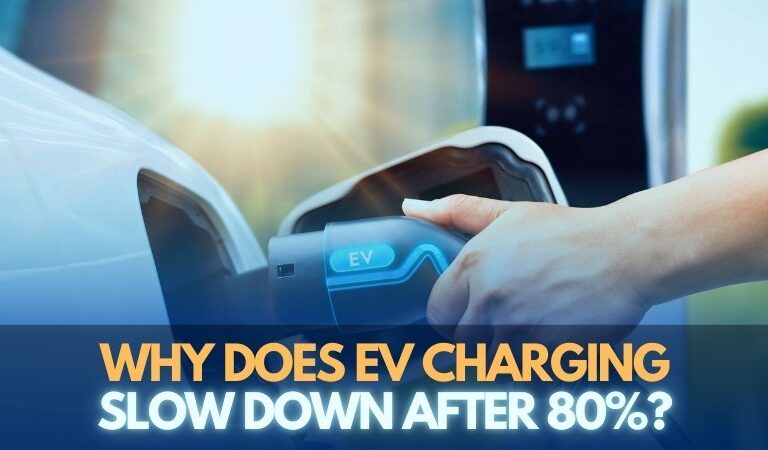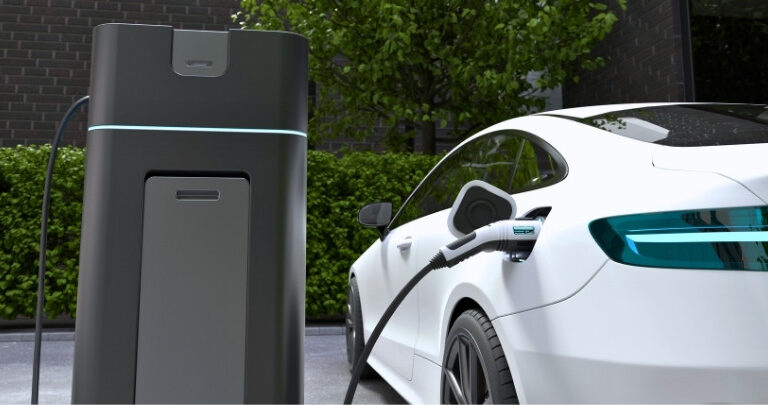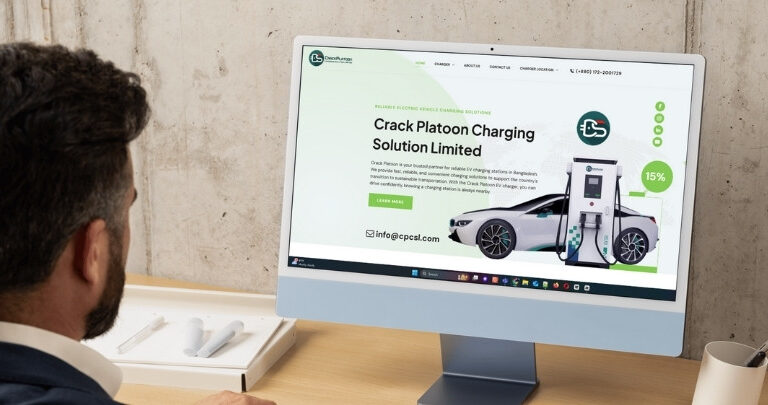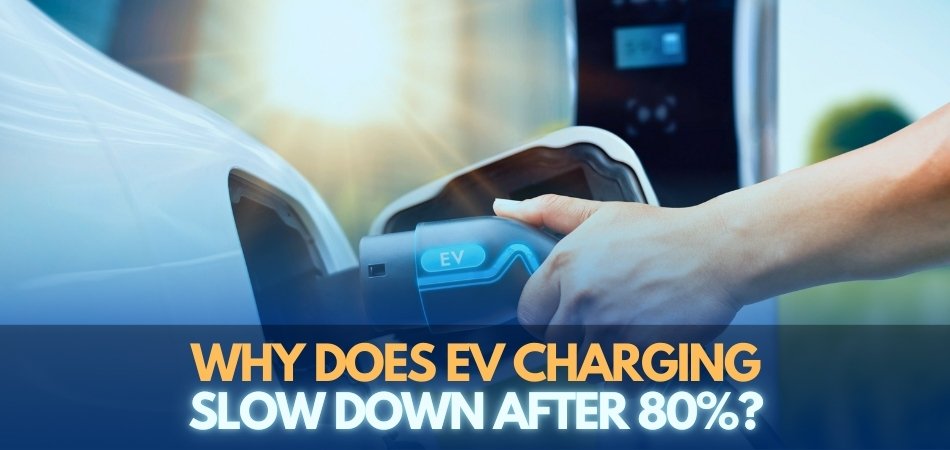We are experiencing a revolution in driving with the introduction of electric vehicles (EVs), which are cleaner, quieter, and more efficient. However, when you watch your EV charge, you may notice something intriguing: charging speeds drop significantly after 80%. So, why does EV charging slow down after 80%?
EV charging slows down after 80% to protect the battery’s health and lifespan. The battery management system reduces charging speed to prevent overheating and stress on cells as they near full capacity, ensuring safer and more efficient charging.
Want to know more about how EV charging works and what this means for your daily driving? Read on to explore the details.
Why Does EV Charging Slow Down After 80%?
When you plug in your electric car, charging feels fast at first. But once it reaches around 80%, things slow down a lot. This might seem odd or even annoying. But there’s a smart reason behind it. Let’s look at what’s really going on and why it matters.

Battery Protection
The main reason charging slows down is to keep the battery safe. When a battery gets close to being full, it becomes more sensitive. Fast charging at that point can damage the cells inside the battery. To avoid this, the car automatically reduces the charging speed. This helps the battery last much longer over time.
Heat Control
Charging a battery creates heat, especially when it’s done quickly. Near 100%, the battery can get even hotter. Too much heat is bad for battery health and can cause problems. Slowing down the charge helps keep the battery cool. This makes charging safer for the car and the people around it.
Smart Charging System
Electric cars use a system called the Battery Management System (BMS). It’s like the brain of the battery. The BMS controls how fast the car charges and makes sure it doesn’t get too hot or too full. Some services, like the Crack Platoon EV Charging Solution, are designed to work smoothly with these systems to manage safe and efficient charging. When it sees the battery is near 80%, it tells the charger to slow down—that way, everything stays in good shape.
Long Battery Life
Fast charging all the way to 100% sounds great, but it’s not good for battery health. If you charge slowly at the top, your battery stays strong for more years. It’s a small change in speed that makes a big difference in how long the battery lasts. This means fewer problems and better performance later on.
Better Car Safety
A slower charge near the top also makes your EV safer. If batteries are pushed too hard when they’re almost full, they can overheat or fail. That’s why slowing things down helps avoid any risky situations. It keeps the car working safely every time you charge it.
Energy Balance
When the battery is nearly full, it takes more effort to push energy inside. It’s kind of like filling a bottle to the very top without spilling. So, the car gently fills the last bit of space. Slowing down helps control that final part carefully and smoothly.
Charging Habits
Most EV drivers don’t need to charge to 100% every day. Stopping at 80% is often enough for daily trips. Slower charging above that point makes people think about whether they really need it. It encourages smarter use of the battery and saves time in the long run.
Charger’s Role
Some fast chargers also slow down automatically as the battery gets fuller. They work together with the car’s system to avoid damage. This teamwork between the charger and the car helps keep everything working the way it should. It also means your battery won’t wear out too fast.
Common Myths About EV Charging Speeds
Many people are still learning how electric vehicle (EV) charging really works. With that, a lot of myths get passed around. Some of these ideas sound true, but aren’t based on facts or science.
- Charging Always Stays Fast: Some think charging speed stays the same the whole time. In truth, it slows after 80% to protect battery health.
- Faster Charging Is Always Better: Quick charging sounds great, but it adds stress to the battery. Slower charging can actually help batteries last much longer.
- Charging Overnight Damages the Battery: Leaving an EV plugged in overnight is generally safe. Modern systems stop charging automatically once the battery is full.
- Any Charger Gives the Same Speed: Not all chargers work at the same speed. Level 1, 2, and DC fast chargers all offer different power levels.
- Bigger Batteries Charge Faster: Larger batteries don’t always mean quicker charging. Charging speed depends on the car’s system and the charger’s output power.
- Slowing After 80% Means a Fault: It’s normal for the speed to drop after 80%. That slowdown protects the battery, not a sign of a problem.
- You Must Always Charge to 100%: Topping off every time isn’t necessary. Charging up to 80% is often enough for daily driving and saves battery life.
- All Weather Affects Charging Speed Equally: Extreme cold affects the battery and charging more than heat. Using tools like a waterproof EV charger helps in wet conditions.
Signs You’re Charging Your EV the Right Way
Charging your electric vehicle seems simple, but doing it the right way really helps your battery last longer. Small actions can make a big difference over time. Check out these signs to make sure you’re charging your EV correctly.

Steady Charging Routine
Charging often, instead of letting the battery run too low, is a smart habit. Keeping the battery between 20% and 80% helps reduce stress on it. Smaller, regular charges are better than waiting for the battery to almost empty. This simple routine helps your battery stay strong longer. It also keeps your EV ready whenever you need it.
Using The Right Charger
Not all chargers work the same way, and picking the right one matters. Level 2 chargers are great for daily use because they charge at a safe speed. Fast chargers are best used only when you’re in a hurry or on a trip. Charging at home with the right equipment makes things easier and more reliable. It also saves time and helps protect the battery.
Battery Doesn’t Get Hot
Charging shouldn’t make your battery feel hot to the touch. Heat is one of the things that can slowly damage a battery. Cooler charging means the battery is working within safe limits. Most EVs have systems to manage temperature, but careful habits help too. When the battery stays cool, it’s a sign everything’s working well.
Charging Stops At 80%
When charging slows down or stops at around 80%, that’s a good thing. It helps the battery stay healthy over time. Charging all the way to 100% every day can wear it out faster. Many EVs are designed to limit charging automatically for this reason. Letting it stop early keeps the battery in better shape.
No Strange Sounds Or Alerts
Charging should be quiet and smooth. Loud sounds, blinking lights, or warning messages can mean something’s not right. A calm, steady charge means the system is working the way it should. You don’t need to hear or see much for it to be going well. Quiet charging is usually a good sign.
Battery Lasts Through The Day
Reaching the end of your day with enough charge left is a clear sign you’re doing it right. It shows the battery is holding power well, and your charging habits are working. There’s no stress about finding a charger during the day. That means your routine is balanced. Charging once and driving all day is a great result.
How EV Charging Power Is Measured and Managed?
The process of charging an electric vehicle might seem simple, but there’s a lot going on behind the scenes. Power isn’t just about plugging in; it needs to be measured and controlled carefully. Being aware of how this works can help you see why charging speeds change. Let’s explore how charging power is measured and managed in EVs.
Measuring Power
Charging power is measured in kilowatts (kW), which shows how fast energy flows into the battery. Higher kilowatts mean faster charging, while lower numbers mean slower charging. The charger and the car both measure power to make sure it’s safe. These details are part of understanding EV charging power insights, which help drivers know how charging speed and battery safety are connected. This helps balance speed and battery health.
Voltage and Current
Power depends on two things: voltage and current. Voltage is the pressure that pushes electricity, while current is the flow of electrons. Together, they decide how much energy reaches the battery. If either voltage or current changes, charging speed can change too.
Battery Management System
Battery Management Systems, or BMSs, are the battery’s brains. It watches the battery’s condition and decides how much power to accept. The BMS can slow down or speed up charging based on temperature and battery health. This keeps the batteries safe and working well.
Charger Communication
The charger and the EV talk to each other during charging. They send signals back and forth to agree on the right power level. This communication helps prevent overloading and overheating. It makes sure the car gets just the right amount of power.
Charging Levels
There are different levels of charging, like Level 1, Level 2, and fast charging. Level 1 uses regular home outlets and charges slowly. Level 2 is faster and requires special chargers. Fast charging uses high power to fill the battery quickly, but is used less often.
Power Management During Charging
Charging power changes during the process to protect the battery. At first, power flows faster to fill most of the battery quickly. Then, as it nears full, the system reduces power to avoid stress on the battery cells. This helps the battery last longer and stay safe.
Crack Platoon EV Charging Solution—Why Is It Popular in Bangladesh?
Electric vehicles are becoming popular in Bangladesh, but charging them has always been a challenge. Crack Platoon EV Charging Solution has stepped in to make this easier. It has quickly become a top choice for many EV owners here. Here are some reasons why its popularity is growing:

Easy Charging
Chargers from Crack Platoon are easy to use and simple to install. People can quickly learn how to plug in and charge without confusion. The chargers work smoothly without complicated steps. Users don’t have to be tech-savvy to charge their cars easily. This makes the charging process stress-free for everyone.
Quick and Reliable
Nobody likes waiting a long time to charge their vehicles. Crack Platoon’s chargers are fast, reducing waiting time significantly. People trust their chargers because they always work reliably. This means fewer interruptions and delays. It makes charging an EV practical and dependable.
Charging App
Crack Platoon has a useful app called “ChargeEasy.” It helps people find nearby charging stations quickly. The app also lets users track their charging progress easily. Users can even schedule charging sessions in advance. This convenience makes charging hassle-free.
Wide Coverage
In many cities across Bangladesh, Crack Platoon is building charging stations. Cities like Dhaka, Chittagong, Sylhet, and others now have good charging options. Having many stations means drivers don’t have to worry about running out of battery. It allows EV users to travel without stress. Wide coverage is one of the reasons people like it.
Safe Charging
Safety is a priority for Crack Platoon chargers. They are designed with smart safety features to avoid problems. Protection against voltage issues makes sure batteries aren’t damaged. Chargers also have safety checks to prevent overheating. People feel safe charging their cars, knowing everything is secure.
Affordable Solutions
Compared to other chargers, Crack Platoon chargers are affordable. This makes EV charging accessible for more people. Lower prices encourage more users to switch to electric vehicles. It’s cost-effective for families and businesses. People appreciate that they don’t have to overspend to charge their EVs.
Trusted Partnerships
Crack Platoon works with well-known companies like Mercedes-Benz Bangladesh. These partnerships make their network strong and reliable. People trust the brand more because big names support it. Such partnerships reassure users that they’re choosing a trustworthy solution. This boosts Crack Platoon’s popularity significantly.
Green Commitment
By promoting electric vehicles, Crack Platoon helps Bangladesh reduce pollution. Using EV chargers means fewer petrol or diesel vehicles on the roads. People support Crack Platoon because it’s eco-friendly. It matches people’s desire to keep their environment clean. This commitment motivates more users to adopt EVs.
What Equipment Helps Maintain Safe EV Charging in All Conditions?
Charging an electric car should be safe, no matter the weather or location. Different equipment is used to make sure both the car and the people around it stay safe. Simple tools and smart technology help avoid problems during charging. Let’s see what makes EV charging safe and dependable in every situation.
Weatherproof Chargers
Some chargers are designed to handle rain, dust, and heat. A waterproof EV charger is built with strong covers to keep water and dirt out. It can be used outside without any worries. Even during heavy rain, it keeps working safely. This means you can charge your EV anywhere, anytime.
Surge Protectors
A surge protector stops sudden spikes of electricity from damaging your car. Power surges can happen during storms or electrical faults. The surge protector acts like a shield for your EV. It makes sure only safe amounts of electricity reach your battery. This keeps both your car and charger safe.
Ground Fault Circuit Interrupter
This special circuit breaker helps prevent shocks. It quickly cuts off power if it senses any leak or fault. This keeps the person charging the car safe from electric shocks. The GFCI is a must-have for every EV charging setup. It’s a simple tool that makes a big difference.
Charging Cables and Connectors
Strong charging cables and connectors are important for safety. Good cables don’t overheat and have extra layers for protection. Connectors should fit tightly to stop water and dust from getting in. Loose connections can be risky, so a strong cable set helps avoid trouble. This keeps charging smoothly and securely.
Smart Charging Systems
Smart systems control the charging process and check for any problems. They can slow down or stop charging if something goes wrong. These systems often show charging details on a screen or app. By using a smart charger, users get updates and warnings. This helps catch issues before they become big problems.
Ventilation and Cooling
Some chargers come with fans or vents to keep things cool. Charging makes the battery and charger warm, and too much heat can be dangerous. Ventilation helps remove heat and keep temperatures safe. It also protects the charger’s inside parts from getting too hot. Good cooling means longer life for your equipment.
Frequently Asked Questions
It’s normal to have questions about electric vehicle (EV) charging, especially when you notice charging slows down after reaching 80%. There are many details behind this process that often don’t get explained. Below are answers to the most common questions people have about EV charging after 80%, so you can better understand what’s happening with your car and charging routine.
Does Slower Charging After 80% Affect My Daily Driving?
Charging slows down after 80%, mainly to protect your battery, but it doesn’t mean you can’t drive as much. For most people, charging up to 80% provides enough range for daily trips. The slower charge near full is more about battery health than limiting your travel.
How Does Charging Speed Impact Battery Warranty?
Most EV manufacturers offer warranties based on battery health and performance. Slower charging after 80% helps keep the battery within safe limits, which can help your battery stay in good shape and avoid issues that might affect your warranty coverage in the long run.
Can I Change Charging Speed Settings in My EV?
Some electric vehicles allow you to adjust maximum charge limits or charging speeds through the car’s settings. However, the automatic slowdown after 80% is built in by most manufacturers for battery safety. You can usually choose when to stop charging, but not speed up past safety limits.
Is It Safe to Leave My Car Plugged in After Charging Slows?
Yes, it’s safe to leave your EV plugged in even after the charging rate drops. The battery management system automatically controls the flow of electricity and stops charging completely when full, so your car and battery won’t be harmed by staying plugged in overnight.
Do All Electric Cars Slow Charge After 80%?
Almost all modern electric cars reduce charging speed as they reach higher battery levels. This practice is used by most brands and models, even though the exact percentage when it happens might vary a little. The goal is always to protect the battery and keep it healthy.
Will Slower Charging Increase My Electricity Bill?
Slower charging after 80% won’t use more energy overall; it just spreads the final part of charging over a longer period. The total electricity used to fully charge your EV remains about the same, so your bill should not increase because of the slowdown.
Why Doesn’t the Charger Stay at Fast Speeds All the Way?
Fast charging all the way to 100% puts a lot of stress on the battery, which can shorten its lifespan. Slowing down after 80% helps the battery stay cooler and reduces the risk of damage. This careful approach keeps your battery in good condition for many years.
Can I Skip the Last 20% to Save Time?
Yes, many EV drivers choose to unplug at 80% to save time. This also helps maintain battery health and is usually enough for daily use. The last 20% takes longer to charge, so skipping it can make your charging sessions much faster.
How Do Charging Networks Handle the 80% Slowdown?
Public charging networks set up their chargers to automatically follow the EV’s battery management system. The chargers communicate with your car to slow down as needed. Some networks may even limit session times to encourage drivers to unplug after 80%.
Conclusion
It’s easy to get impatient while waiting for your electric car to charge, especially when things slow down at the top. But understanding why does EV charging slow down after 80% actually helps you become a smarter, more confident EV owner. This slowdown isn’t just a random quirk—it’s your car’s way of protecting its battery and making sure you get the most out of every charge.
By managing the charging speed, your vehicle’s systems are quietly working in the background to keep the battery healthy, safe, and long-lasting. This means fewer worries for you and better performance every day. It’s like giving your car a little extra care each time you plug in.
So the next time your charging speed drops, don’t stress. Instead, be pleased that you’re prolonging the life of your battery and keeping your car reliable.

